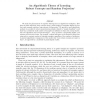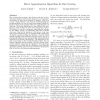388 search results - page 6 / 78 » The covering number in learning theory |
DM
2010
13 years 7 months ago
2010
Let m be a positive integer and let G be a graph. We consider the question: can the edge set E(G) of G be expressed as the union of a set M of matchings of G each of which has siz...
SIGCSE
2004
ACM
14 years 23 days ago
2004
ACM
We describe the instructional software JFLAP 4.0 and how it can be used to provide a hands-on formal languages and automata theory course. JFLAP 4.0 doubles the number of chapters...
FOCS
1999
IEEE
13 years 11 months ago
1999
IEEE
We study the phenomenon of cognitive learning from an algorithmic standpoint. How does the brain effectively learn concepts from a small number of examples despite the fact that e...
SODA
2001
ACM
13 years 8 months ago
2001
ACM
Bin covering takes as input a list of items with sizes in (0 1) and places them into bins of unit demand so as to maximize the number of bins whose demand is satis ed. This is in ...
GECCO
2007
Springer
14 years 1 months ago
2007
Springer
The application of resource-defined fitness sharing (RFS) to shape nesting problems reveals a remarkable ability to discover tilings [7, 8]. These tilings represent exact covers...


